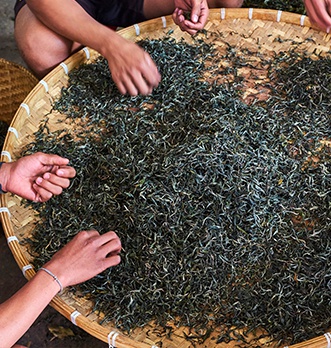
This type of post-fermented tea originates from Yunnan, a Chinese province. Stored in its distinctive cake or brick forms, it improves over time. The production of Pu erh is also unique. It can take several years. Depending on the processes used, we obtain raw or cooked Pu Erh teas. They vary in terms of taste and appearance.
The steps in making Pu Erh tea
Before it can be tasted, Pu Erh undergoes a long transformation. It begins with the picking of wild tea plant leaves. After harvesting, they are spread out for several hours in the sun or in a dry place.
Then, the tea is quickly passed at high temperature. This process, similar to coffee roasting, aims to reduce moisture and stop any oxidation. Once cooled, the leaves are rolled and kneaded. This step in the production of Pu Erh helps to release the aromas. After further drying, the leaves are completely dehydrated.
At this point, the product obtained, the Mao Cha, is consumable. However, additional treatments are necessary to have a raw or cooked Pu Erh.
The ancestral way to obtain raw tea
Traditionally, Mao Cha is compressed into different shapes. The most common are cake and brick. This is achieved by softening the tea leaves with steam, then pressing them into a mold.
The origin of this method dates back to when Pu Erh was exported from China by road. This facilitated storage and transport, unlike loose tea. At that time, the tea underwent weather conditions throughout the journey and fermented. Today, this aging is reproduced by placing the product in a humid cellar for several years, then in a dry cellar.
The modern process to create cooked tea
For the production of cooked Pu Erh, fermentation takes place before molding. It is accelerated by producers. They lay the tea on the ground, sprinkle it with water, then cover it with a tarp for at least 45 days. Microorganisms transform the Pu Erh and the post-fermented tea is obtained.
It can be sold loose or molded. It can be consumed immediately or stored for a few years to mature.
The differences between raw and cooked Pu Erh
Depending on the Pu Erh manufacturing techniques, we obtain either a raw tea (Sheng Cha) or a cooked tea (Shu Cha). But beyond this aspect, they can be distinguished by their color and taste.
The particularities of Sheng Sha
Raw Pu Erh consists of leaves with a color similar to green tea. They can turn brown if the tea is stored for a long time. It produces an infusion ranging from pale yellow to orange, depending on maturation and oxidation. When drunk young, this tea is light, fresh and spicy. If left to age, the notes are more fruity, with a sweeter touch.
Characteristics of Shu Cha
Cooked Pu Erh belongs to the family of dark teas. Its color can range from black to brown, with a red reflection. The strong fermentation of this drink gives it a unique taste. The thick liquid offers aromas reminiscent of undergrowth. In the mouth, it is round and without bitterness.
Some of these teas, aged for a long time, are of high quality. They can be sold at very high prices, just like an excellent bottle of wine.
Depending on the manufacturing conditions of Pu Erh, we obtain 2 distinct teas. In addition to its original character, this Chinese tea has medicinal properties. Among other things, it helps with weight loss and cholesterol control.